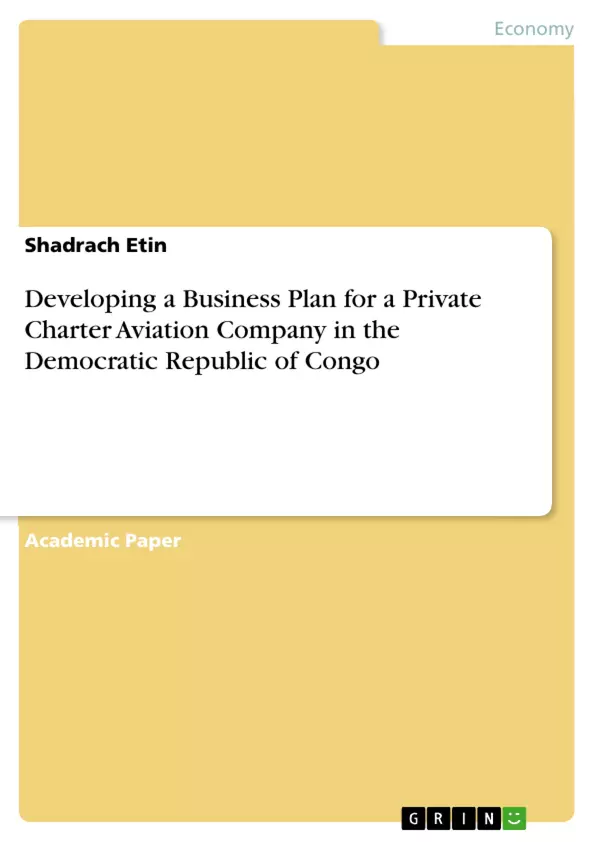This paper aims to develop a business plan for a private charter aviation company in the Democratic Republic of Congo.
The airline industry in Congo is not so advanced since Congo is a developing country, and there are limited companies that offer these kinds of services. For this reason, there are many opportunities in the market for new charter companies. Moreover, a significant number of customers will be a requirement for opportunities to create a positive and effective growth strategy. There is also high speed and efficient travels since customers are not required to wait in line to check-in at airport counters or wait around the baggage claim area, which saves a lot of time for business people. In addition to this, air transport is not affected by traffic congestion, which also saves time.
Since the government in the Democratic Republic of Congo has changed, it has worked towards finding investors in various economic sectors as well as adopting new business ideas that could help improve the economy. As a result, this has made it easier for new companies to join the airline industry. There are also increased rates of accuracy and predictability of outcomes due to the introduction of new models and the application of advanced technology in carrying out the companies' operations.
Inhaltsverzeichnis (Table of Contents)
- Business Model
- Company Profile
- Business Model Canvas Description
- Key Resources
- The Need and Opportunity
- Valued Customers
- Major Cost Drivers
- Revenue Streams
- Key Success Factors
- Assessment of the Sector
- Competitors
- Factors from the General Environment
- Suppliers
- New Venture's Source of Advantage
- Marketing Plan
- Marketing Overview and Trends
- Segmentation and Target Segments
- Marketing Mix
- Product or Service Strategy
- Pricing Strategy
- Channel Strategy
- Communication Strategy
- Operation Plan
- Identification and Map Processes
- Location
- Layout and Design
- Equipment
- Service Capacity
- Milestones
- Procurement and Inventory Management
- Parameters Associated With Operations Plan
- Launch Plan
- Financial Plan
- Start Up Cost of the First Year
- Major Cost Drivers
- Revenue, Sales and Profit Calculation
- Human Resource Plan
- Organization Structure
- Managing Structure
- Job Descriptions
- Human Resource Policies
- Legal Aspects
- Procedures for Legal Operation
- Procedures for Legal Operation
- Ownership
- Operation Areas (Aerodrome)
- Company Growth and Development
- Factors to Consider for Growth and Development
- Continuous Service Improvement
- Risks and Contingency Plan
- Climate Change and the Effects
- Contingency Plan
- Private Flight Route
- Communication
- Emergency Plane
- Developing a sustainable and profitable business model for private charter aviation services in the Democratic Republic of Congo.
- Identifying and targeting key customer segments to ensure market penetration and growth.
- Creating a competitive advantage through efficient operations, personalized customer service, and the adoption of modern technology.
- Navigating the complex legal and regulatory landscape of the aviation industry in the DRC.
- Developing a comprehensive contingency plan to mitigate risks and ensure business continuity.
- Business Model: This chapter introduces Kinshasa Helicopter Company (KHC) as a new private charter aviation entity in the Democratic Republic of Congo. It outlines KHC's mission, objectives, and vision, highlighting the company's commitment to providing efficient and personalized flight services. The chapter also describes the company's location, target market, and key partnerships.
- Assessment of the Sector: This chapter analyzes the competitive landscape of the private aviation industry in the Democratic Republic of Congo. It identifies key competitors, analyzes the impact of factors from the general environment, and discusses KHC's unique source of advantage.
- Marketing Plan: This chapter details KHC's marketing strategy, including target market segmentation, the marketing mix (product/service, pricing, channel, and communication), and key marketing trends. It outlines KHC's approach to positioning itself within the market and attracting clients.
- Operation Plan: This chapter outlines KHC's operational strategy, encompassing process mapping, location selection, facility design, equipment acquisition, service capacity planning, and procurement management. It also addresses key operational milestones and parameters.
- Financial Plan: This chapter presents a comprehensive financial plan for KHC, including start-up costs, major cost drivers, revenue and profit calculations, and key financial projections. It provides insights into the company's financial viability and growth potential.
- Human Resource Plan: This chapter outlines KHC's human resource strategy, encompassing organizational structure, job descriptions, human resource policies, and legal aspects. It emphasizes the company's commitment to building a strong and capable team to support its operations.
- Company Growth and Development: This chapter explores strategies for KHC's growth and development, focusing on factors to consider for expansion, continuous service improvement, and potential diversification opportunities.
- Risks and Contingency Plan: This chapter addresses potential risks and challenges facing KHC, including climate change, operational disruptions, and security concerns. It presents a detailed contingency plan to mitigate these risks and ensure business continuity.
Zielsetzung und Themenschwerpunkte (Objectives and Key Themes)
This business plan outlines the strategy and operations of Kinshasa Helicopter Company (KHC), a new private charter aviation entity in the Democratic Republic of Congo. The main objective of KHC is to achieve profitability within the first two years of operation and grow into the leading private aviation charter company in the country, ultimately aiming to become a top player in Africa.
Zusammenfassung der Kapitel (Chapter Summaries)
Schlüsselwörter (Keywords)
This business plan for Kinshasa Helicopter Company focuses on the development and implementation of a sustainable business model for private charter aviation services in the Democratic Republic of Congo. Key themes and concepts include market analysis, target market segmentation, competitive advantage, operational efficiency, financial projections, human resource management, risk mitigation, and contingency planning. The plan also addresses the legal and regulatory landscape of the aviation industry in the DRC, highlighting the importance of compliance and ethical business practices.
- Quote paper
- Shadrach Etin (Author), 2021, Developing a Business Plan for a Private Charter Aviation Company in the Democratic Republic of Congo, Munich, GRIN Verlag, https://www.grin.com/document/1038416



